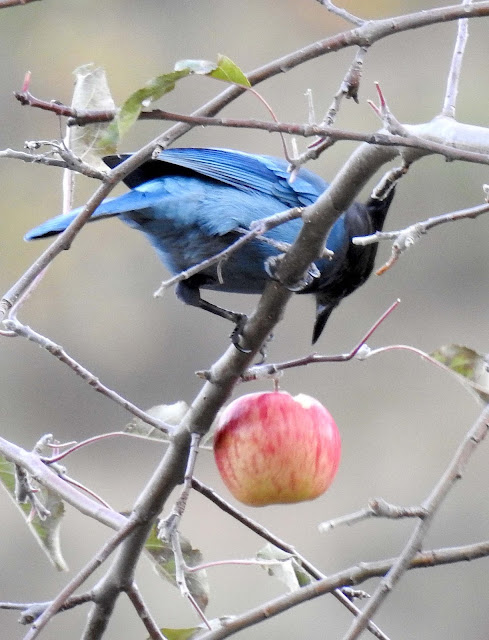Cedar Waxwing on Rose hips - Bombycilla cedrorum
We have LOTS of domestic apple and pear trees in our neighborhood that are a great food source for many species of wildlife. We also have many species of fruit-bearing shrubs such as wild rose, grape, dogwood, mistletoe, hawthorn, madrone, and even poison oak. At this time of year many birds are switching from a diet of insects to a diet of fruits and berries. The colder weather has made the insects mostly inactive and hard to find, whereas many fruits have recently ripened.
Cedar Waxwings are fruit eaters year-round. They migrate through our neighborhood in flocks, several times a year when fruit becomes available. They also eat insects, flowers, and buds. Their name comes from their habit of eating "cedar" (actually "juniper") berries, and for the red waxy tips on the ends of their secondary flight feathers. The reason for the waxy tips, found on both males and females, is uncertain. Cornell University states, "Red secondary tips may be important status signals that function in mate selection." These handsome birds migrate down to lower elevations during the winter. Some even travel as far south as Costa Rica!
American Robin on Dogwood - Turdus migratorius
This past week American Robins and Cedar Waxwings have been flocking to a single dogwood tree in our neighborhood, and eating all the "fruits"! I've really enjoyed watching them for hours as they descend on the tree. It's taken a week, but they have effectively stripped the tree bare of its fruits! I wonder where they'll go next!
Steller's Jay - Cyanocitta stelleri
This was a great year for apples! There have been hundreds of them on the local trees. Over this past months, the fruits have been eaten by a variety of wildlife. Steller's Jays are opportunistic omnivores, that live here year-round. However, I was surprised to see a Steller's Jay pecking on an apple!
Columbian Black-tailed Deer - Odecoileus hemionus columbianus
I came across this deer and her fawn eating apples a few weeks ago!
Black Bear - Ursus americanus
I haven't seen any Black Bears this year, but I see new piles of their scat every day! They even climbed one of our apple trees and bent the branches down into a kind of platform, from which they ate almost all the apples!
Black Bear scat
This bear scat has a combination of apples and grapes in it. Almost all of the apples have been eaten in our neighborhood, including the ones that fell to the ground. I'm thinking that the bears will go into hibernation soon, as wild foods are becoming scarce for them.

Red-winged Blackbird (female) - Hermit Thrush
Agelaius phoeniceus - Catharus guttatus
Migrating Through
This week I luckily saw a Hermit Thrush! It will move on to lower elevations once the weather gets colder. Right now it's feeding on berries and any insects it can find. A female Red-winged Blackbird stopped by our garden one afternoon and filled up on sunflower seeds! It's probably on its way to California's Central Valley for the winter.
Pine Siskins - Carduelis pinus
A small flock of Pine Siskins feasted on sunflower seeds in our garden this week. These little birds migrate to wherever seeds are available! I love seeing them stop by in the Fall! Unlike most songbirds, they can stay in the higher elevations if seeds are available. They put on a layer of fat for winter, and can speed up their metabollic rate to stay warm on cold nights. They eat a variety of seeds including pine, cedar, hemlock, alder, maple, thistle, and grass seed. They will also eat garden vegetable stems, insects, and sap from trees. They travel in small to large flocks all year. One morning two winters ago, 122 of them landed and feasted on thistle seeds that I had scattered on the snow!!!
Peregrin Falcon - Falco peregrinus
Falcon Sighting!
I saw this Peregrin Falcon one morning way up in the top of a dead tree!!! About four or five Steller's Jays kept landing really close and cawing at it. The Falcon repeatedly flew off, circled around, and landed in the same tree. Each time it came back the Steller's Jays came back too! It finally flew off for good! What a thrill it was to see it! I wonder if it's the same one I photographed this summer ("Cooler Weather" blog - August, 2019)!
What insects made this nest?
What are the Herps doing?
What's happening in California's central valley?
Check back next week for the answers to these questions and more!
If all of a sudden you haven't been getting email notices of my blog being published, just sign up again on my blog. I don't know why you got "unsubscribed". It's some kind of problem with Blogspot.com and/or FeedBurner.com. I apologize for this glitch!
Your questions and comments are greatly appreciated!
Please email me at northyubanaturalist@gmail.com









No comments:
Post a Comment